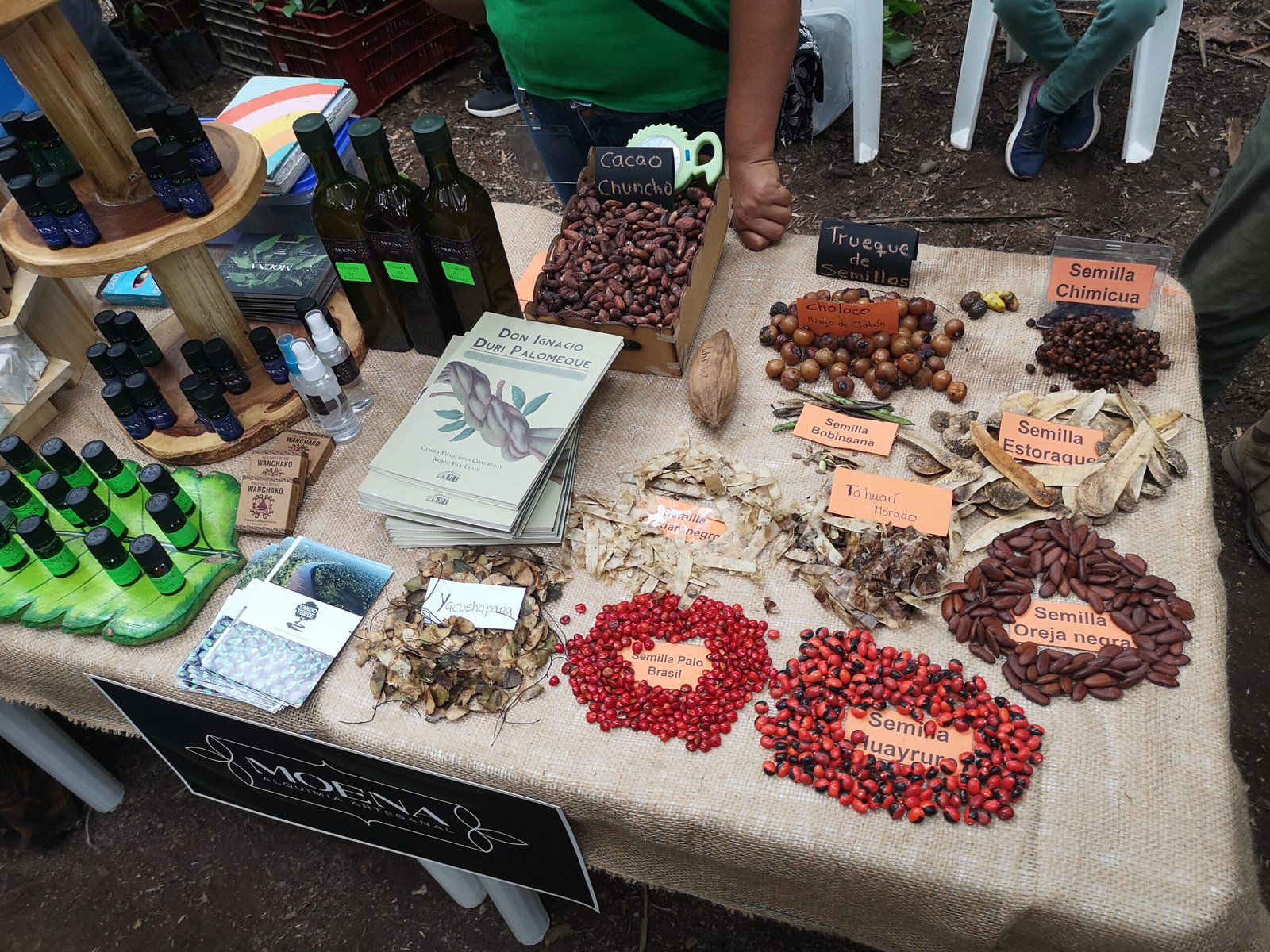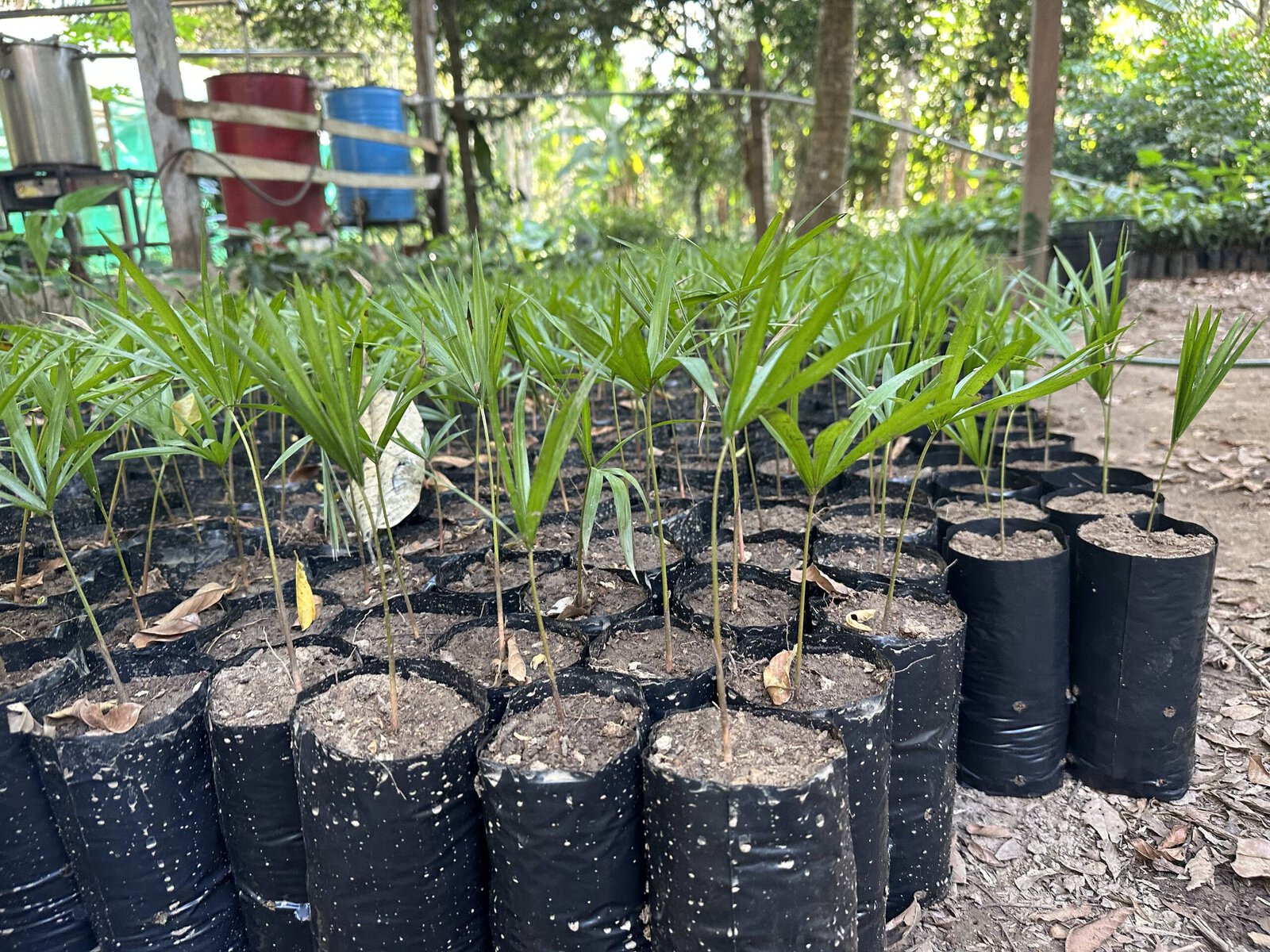This story was originally co-published by Reasons to be Cheerful and the Outrider Foundation.
If the Amazon rainforest were to have a department store, this is what it might look like.
Within the sprawling, 130-hectare “living seed bank” at Camino Verde, a project in the richly biodiverse region of Madre de Dios in Peru, there are over 400 species of native trees and plants with often incredible properties little-known to science.

There are “dragon’s blood” trees with thick red sap that heal wounds quickly; there’s Flemingia (wild hops), a leafy shrub that has the rare ability to fix nitrogen in the soil, making it more fertile; there are towering, thick trunks of ironwood, one of the strongest timbers in the world. Meanwhile, the bark of the tawari tree produces “killer T-cells” that fight cancer. All of these are coexisting in this great, Avatar-esque library of natural wonders.
“I grew up in the forest,” says Froilan Rodríguez, who works for Camino Verde as a specialist seed collector, while strolling along one of the pathways that cuts through the jungle. “It can provide everything we need. It’s a magical place.”
Camino Verde sits alongside the Tambopata River, whose basin is one of the most ecologically rich areas on the planet. It is home to endemic species of birds, reptiles, mammals such as jaguars and pumas, and notably, at least 1,255 plant species.
However, the unique biodiversity of this region — much of which is still little-studied by scientists — has been disappearing over the past decades.
In 2020, Peru recorded its highest levels of deforestation in history, with a total of 203,272 hectares of Amazonian forest lost — an area 2.5 times the size of New York City — due largely to logging and mining, according to Peru’s environment ministry. Since 2001, almost three million hectares have been deforested. It’s a grim picture seen across the tropics as tree cover is being lost legally and illegally.
“In Madre de Dios, they cut many trees,” adds Rodríguez, who was himself a miner before he came to realize the negative impacts. “We are losing many special species.”
But Camino Verde, or Green Way, is fighting to preserve these native plants before they’re lost forever — and it is helping them to blossom in the long-term through the support of (and benefit to) local communities.

The nonprofit, which was officially registered in 2007, was set up by the American agroforester Robin Van Loon, now the nonprofit’s executive director, after he visited the area as a student. Camino Verde is based in the buffer zone of a nature reserve in Tambopata province, with a team of about 25 Peruvians leading the effort.
Van Loon was fascinated by the cultural side of Amazonian agriculture and sought to learn more about the traditional methods. But when he asked around, even at local nurseries and government offices, about native species — “What season do these trees produce seeds?” or “Does anyone still plant these?” — most people had no idea. He could find people’s houses made out of a certain tree, but not the seeds.
“It was striking how at a community level you could go from having a lot of a type of tree to nothing in the blink of an eye,” says Van Loon. “If a tree is being lost from the wild, and nobody knows what the seeds look like, it is on the way to extinction.”
Weighed down by negative news?
Our smart, bright, weekly newsletter is the uplift you’ve been looking for.The prized, reddish-brown timber mahogany, for example, is already commercially extinct in Peru due to overexploitation. And many other species, such as Brazilian rosewood, a valuable timber known for its floral aroma (it was an original ingredient in Chanel No.5 before overharvesting pushed up prices), are critically endangered.
So, as Van Loon puts it: “We rolled up our sleeves and got planting.”
The concept of Camino Verde is to cultivate native species in a “living seed bank” that safeguards their future as well as actively promoting their sustainable use throughout the region and other parts of Peru as a source of livelihoods for communities. One of its key arguments is that the Amazon rainforest can be restored within our lifetimes.
On the surface, it looks like a normal, albeit particularly mesmerizing, stretch of tropical jungle, save for the seedling nursery and grouping of wooden huts used for research and accommodation. Rather than being a traditional kind of dry storage facility, the seeds are collected directly from the forest floor during the relevant seasons.
The seed bank’s efforts have been focused on the most overexploited and endangered species, and to date more than 200,000 trees have been planted, with tens of thousands of tree seedlings produced at their tree nursery every year and donated or sold at-cost.

For example, Camino Verde provided 40,000 seedlings to the Amazonian Scientific Innovation Center (CINCIA), a nonprofit that is restoring degraded former mining lands in Madre de Dios. It also donated 20,000 seedlings to the municipality of Puerto Maldonado, the departmental capital city, whose main square and other public spaces now contain an array of native plants.
Silvia Bacci, a seed biologist and project officer for Latin America at the Royal Botanic Gardens, Kew, in London, which is home to one of the world’s most important seed banks, says that the “living” aspect of Camino Verde’s project is particularly important given the climate and conditions of the region.
“Especially in the Amazon area, species of trees from rainforests can’t be stored in seed banks, because they don’t survive when you try to dry them,” she says of the standard process, which usually requires seeds to be stored at -20° Celsius (-4° Fahrenheit).
According to Bacci, these conservation efforts are particularly urgent in areas where little-studied habitats are under threat. “You can store these seeds and they can be used for propagation in the future,” she says. “These places hold a lot of biodiversity. The percentage of plant species that have likely not been discovered is high.”
But crucially, Camino Verde believes that one of the most effective ways to preserve native seeds is to encourage the regular use of them among Amazonian communities. It provides seeds and seedlings to Indigenous and local farmers to promote a switch away from non-native cash crops like corn, rice and yuca, which in recent years have come to dominate agriculture to the detriment of biodiversity.

Don Juan Rafaele, a 55-year-old farmer, began working with Camino Verde in 2011. Before, he grew standard non-native crops like corn and rice, but after he was gifted seeds from the project, Rafaele began to cultivate native citrus fruits, cupuaçu, a large Amazonian fruit with a fleshy white interior, and moena, which can be made into essential oil, on his seven hectares of land near the Tambopata River.
“These crops are more valuable for me,” says Rafaele. “And unlike corn and rice, they can be harvested throughout the whole year, so my income is steadier.”
At the same time, the organization has been helping local communities to develop non-timber products (online store) from native species, including Amazonian vanilla, wild cacao and honey made by stingless bees, as well as essential oils from species like Brazilian rosewood that are hand-processed in a distillery and distributed internationally.

According to Van Loon, most reforesting efforts in Peru tend to involve non-native species like teak and eucalyptus, since they have known economic benefits and are well understood species in the world of reforestation. But they aren’t the only way.
“The seed bank was never intended to be a museum,” says Van Loon. “These are native species that can provide real benefits. We are very interested in testing the economies of sustainable products that can be sourced from these trees.”

Since 2013, Camino Verde has also been working with Indigenous communities in the Amazonian region of Loreto, another frontline of deforestation, with almost 150 families involved in projects that have reforested more than 75 hectares of land.
“The best, most effective way to conserve these seeds is to link them to uses for local communities,” adds Bacci. “We need more networks outside of the West like this.”
To boost the supply, Camino Verde opened up a satellite site in Madre de Dios, a 15-hectare area known as La Joya that they reforested. It produces tens of thousands of tree seedlings and is also the main center for training sessions for local farmers.
“Before it was filled with only bamboo grass, but it’s become a complete forest,” says Percy Leba, a 39-year-old farmer who runs La Joya.

Now Camino Verde’s land in Madre de Dios, which was set up using agroforestry methods — mixing agriculture with trees — in order to maximize biodiversity, has been recognized as a conservation area by Peru’s Ministry of the Environment.
And the fruits of that labor are impossible to miss: Camino Verde’s lands teem with marvelous creatures, including great lines of tropical centipedes that could reach 10 meters in length; hundreds of white and yellow butterflies sucking up minerals from the riverbanks; and howler monkeys letting out primal screams from the upper canopy.
Looking ahead, Camino Verde is spreading the seeds of its knowledge even further. The team is currently creating a digital database known as Our Trees, which contains information on over 650 species that they have either planted or registered in the wild, featuring known names, photos, botanical insight and practical uses.

And in June, they published an English translation of the memoir of Don Ignacio, a local shaman who inspired the project, full of illustrations of the plant and tree species in Camino Verde and intended to be a “rich visual resource.”
“It’s very hard to come by this knowledge if it exists at all for Amazonian species,” says Van Loon, from his base at the eastern edge of Peru, not far from the tripoint border with Brazil and Bolivia. “We want to make sure our learnings don’t just remain with us.”




